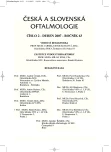Orbital Apex Syndrome of the Aspergilus Ethiology – a Case Report
Authors:
E. Fric 1; M. Rehák 1; I. Vlčková 2; S. Buřval 3; O. Chrapek 1; J. Řehák 1
Authors‘ workplace:
Oční klinika FN, Olomouc, přednosta doc. MUDr. Jiří Řehák, CSc.
1; Otorinolaryngologická klinika FN, Olomouc, přednosta
prof. MUDr. Ivo Stárek, CSc.
2; Radiologická klinika FN, Olomouc, přednosta doc. MUDr. Miroslav
Heřman, Ph. D.
3
Published in:
Čes. a slov. Oftal., 63, 2007, No. 2, p. 117-122
Overview
The authors present a case report of a patient, in whom after a head injury the monolateral blindness occurred. Because of autoimmune thrombocytopeny the patient was treated with long-term corticosteroids. The clinical findings corresponded with the orbital apex syndrome. According to the results of the CT and MRI examinations, the sphenoidotomy was indicated, and the histological findings verified fragments of paranasal sinuses’ aspergiloma. During the next course of the disease, despite antimycotic therapy, the progression of the aspergiloma in to the anterior cranial fossa occurred. Invasive sino-orbital aspergilosis, after the penetration of the infectious agent across the wall of the sinus, may cause the orbital apex syndrome with paralysis of all three cranial nerves innervating the extraocular muscles, sensoric defect in the area of the ophthalmic nerve and the involvement of the optic nerve.
Key words:
orbital aspergilosis, sphenoidotomy, autoimmune thrombocytopeny
Labels
OphthalmologyArticle was published in
Czech and Slovak Ophthalmology

2007 Issue 2
Most read in this issue
- Intraoperative Floppy Iris Syndrome
- Orbital Apex Syndrome of the Aspergilus Ethiology – a Case Report
- The Cooperation between the Ophthalmologist and the Endocrinologist in the Treatment of the Endocrine Orbitopathy
- Functional Examination of Retinal Vessels in Patients with Central Retinal Vein Occlusion
